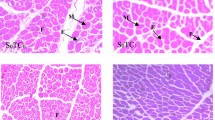Summary
Three hundred Warren Isabrown female day old chicks were raised for 18 weeks in 3 distinct artificial climates described as temperate (20°C, 60% RH), hot dry (32°C, 40% RH) and hot humid (32°C, 90% RH). At 18 weeks each group was divided into 3 and re-allocated to 3 similar air-conditioned laying rooms as during the growing period. Different diets were fed to the 3 groups up to 18 weeks. The energy needed in order to produce the same average live body weight at 18 weeks was similar in all the 3 climatic chambers. The effect of treatments in the growing period was not significantly different (P>0·05) for most of the parameters subsequently measured during the laying period. The exception was the body weight gain between 18 and 38 weeks and the food and energy intakes. However, apart from the sexual maturity, all these parameters were negatively influenced (P<0·05) by the effect of hot climates during the laying period irrespective of method of rearing. The results of this study seem to indicate that ambient temperature experienced during the first 18 weeks after hatching has little effect on subsequent productivity and that rearing birds at high ambient temperature does not acclimatise them to these conditions better than rearing them under temperate conditions.
Resumé
Trois cents poussins femelles d'un jour de souche Warren Isabrown ont été élevés jusqu'à l'âge de 18 semaines dans 3 climats artificiels distincts, respectivement tempéré (20°C, 60% HR), chaud sec (32°C, 40% HR) et chaud humide (32°C, 90% HR). A l'âge de 18 semaines chaque lot d'oiseaux a été divisé en trois et réparti à nouveau en 3 cellules de ponte conditionnées de la même façon que les salles de croissance. Différentes rations alimentaires sont nourries aux oiseaux jusqu'à l'âge de 18 semaines. La consommation d'énergie nécessaire pour produire le même poids vif à 18 semaines a été sensiblement égale dans les 3 climats. L'effet des traitements en période de croissance n'a pas été significativement différent (P>0·05) sur la presque totalité des paramètres étudiés en ponte, exception faite du gain de poids vif 18–38 semaines, des ingérés alimentaires et énérgétiques. Par contre, à l'exception de la maturité sexuelle, tous ces paramètres ont à chaque fois été influencés négativement (P<0·05) par les effets des climats chauds en période de ponte, indépendamment du climat d'élevage. Les résultats de cette expérience semblent indiquer que la température expérimentée pendant les 18 premières semaines après l'éclosion a eu peu d'effet sur la productivité ultérieure, et que l'élevage des oiseaux à hautes températures ambiantes ne leur confère pas une meilleure acclimatation à ces mêmes conditions que lorsqu'ils sont élevés en milieux tempérés.
Resumen
Se leavantaron 300 pollitas de un día de nacidas, Warren Isabrown, por 18 semanas en 3 climas diferentes; templado (20°C, 60% HR), seco caliente (32°C, 40% HR) y caliente húmedo (32°C, 90% HR). A las 18 semanas cada grupo fue dividido en 3 y re-instalado en 3 cuartos de postura con aire acondicionado durante el período de crecimiento. Los 3 grupos recibieron diferentes dietas hasta las 18 semanas. La energía necesaria para producir el mismo peso promedio a las 18 semanas fue el mismo en las tres cámaras climáticas. El efecto del tratamiento durante el período de crecimiento no fue significativamente diferente (P>0·05) para la mayoría de parámetros medidos subsecuentemente durante el peródo de postura. La excepción fue el aumento en peso corporal entre las 18 y 38 semanas y la energía consumida. Sin embargo, aparte de la madurez sexual, todos los parámetros fueron afectados negativamente (P<0·05) por el efecto de los climas cálidos durante el período de postura, irrespectivamente del manejo. Los resultados de este estudio parecen indicar, que la temperatura ambiente experimentada durante las primeras 18 semanas después del nacimiento, tuvo poco efecto sobre la productividad y que la crianza de aves a temperatura ambiente alta, no las aclimata para esas condiciones mejor que levantandolas bajo un clima templado.
Similar content being viewed by others

References
Arad, Z. &Marder, J. (1982). Effect of gradual acclimatization to high ambient temperatures on egg shell quality of the Sinai Bedouin fowl, the commercial White Leghorn and their crossbreds.British Poultry Science,23, 113–119.
Blake, A. G., Mather, F. B. &Gleaves, E. W. (1984). Dietary self-selection of laying hens adequate to overcome the effects of high environmental temperature.Poultry Science,63, 1346–1349.
Guide d'Elevage Isabrown (1985). Institut de Sélection Animale (ISA), 2è Edition, 1985. Edité par ISA, 119 Avenue du Maréchal de Saxe, 69003 Lyon, p 11.
Henken, A. M. J., Groote, S. &Van Der Hel, W. (1983). The effect of environmental temperature on immune response and metabolism of the young chicken. IV — Effect of environmental temperature on some aspects of energy and protein metabolism.Poultry Science,62, 59–67.
Lebart, L., Morineau, A. &Fenelon, J. P. (1979). Traitement des données statistiques. Méthodes et Programmes. Edité par Dunod, Paris, pp 230–237.
Meltzer, A. (1985). Acclimatization to ambient temperature and its nutritional consequences. In: Proceedings on the Fifth European Symposium on poultry nutrition. (Ed. S. Bornstein). Jerusalem, Israel, pp 109–120.
Njoya, J. (1986). Adaptation climatique de la poule pondeuse et métabolisme thyroïdien. Etude bibliographique. ENSA de Rennes, 28 pp.
Picard, M. (1985). Heat effects on the laying hen. Protein nutrition and food intake. In: Proceedings of the Fifth European Symposium on Poultry Nutrition. (Ed. S. Bornstein). Jerusalem, Israel, p 65-72.
Snedecor, G. W. (1956).Statistical Methods. 5th ed. Ames Iowa State University Press. pp 251.
Uzu, G. (1986). Effet de l'hygrométrie sur les performances de ponte de la poule pondeuse soumise à une temperature élevée. In: 7è Conférence Européenne d'Aviculture. (Ed. M. Larbier). Paris, pp 776–784.
Van Kampen, M. (1980). The effect of a short term heat stress or feed restriction on body weight, subsequent laying performance and body composition of pullets.Archiv Geflügelkd,44, 124–128.
Author information
Authors and Affiliations
Rights and permissions
About this article
Cite this article
Njoya, J., Picard, M. Climatic adaptation of laying hens. Trop Anim Health Prod 26, 180–186 (1994). https://doi.org/10.1007/BF02241082
Accepted:
Issue Date:
DOI: https://doi.org/10.1007/BF02241082


